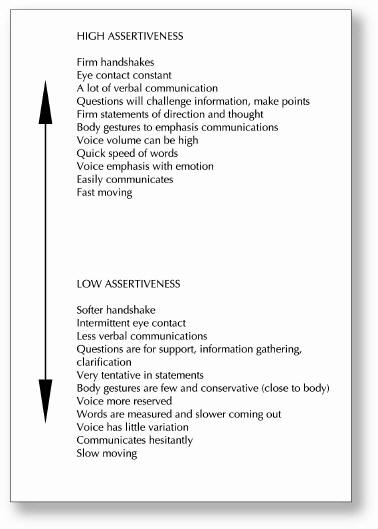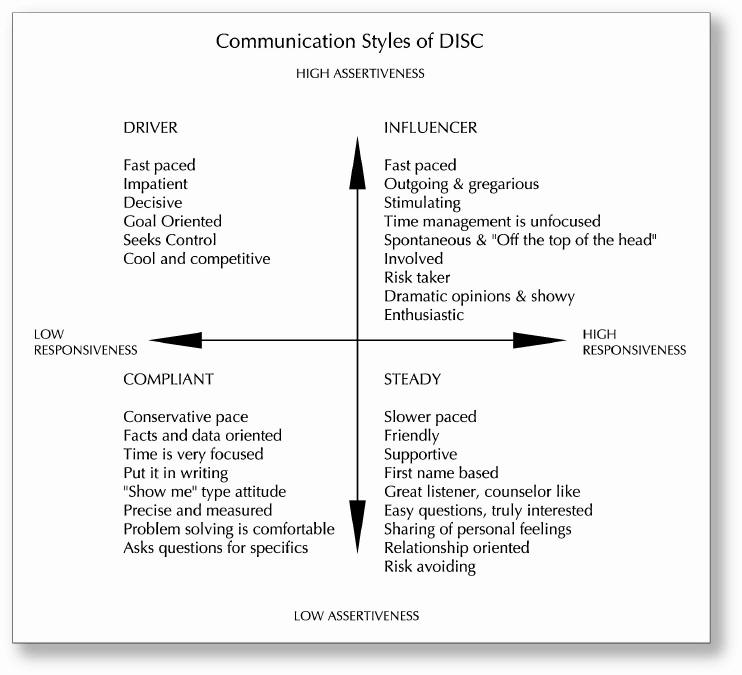

Selling Skills using DISC
How to use DISC profiles in a selling environment
By: Kordell Norton, ©copyright 2007, all rights reserved
To connect with the customer it is helpful to present and converse in ways that THEY would prefer, and not necessarily the way the sales person would like. If the customer is thoughtful, analytical and deliberate and the sales person is “fly by the seat of the pants” . . . then there is going to be a certain amount of disconnect and stress.
The DISC behavior models allow an understanding of how we might recognize and customize our message so that it gets through the customer's mental filtering system. DISC looks at how people interact with the world based on RESPONSIVENESS and ASSERTIVENESS. To see the two ends of these spectrums, read the charts below.

Note: This document is not meant to explain DISC in its fullness, but to give some insights for selling and marketing.

By looking at these behaviors we can see how we might adapt our behavior to match that of the other person, customer, or prospect.
Are we talking about being manipulative? No. For example, let’s say you have a medical condition that restrains you from eating or drinking certain foods. Although you may be at a party where others are drinking, it doesn’t mean you have to drink. You quietly and humbly substitute a different action (perhaps a diet soft drink) so you “fit in”. So it is with selling and behavior based on the DISC model. We may slightly alter our communication style so that the other person will more readily see and/or hear us and our message. The more flexible we are in making our style match the other person’s style, the more they will perceive you favorably.
By combining the ASSERTIVENESS and RESPONSIVENESS scales we can see the four quadrants that make up the DISC profile and how people tend to communicate in each.

Although the DISC profile helps us understand how to connect with others, the bottom line is that trust, honesty, rapport and creditability are still most important. The guidelines below are there to help you move toward more trust, honesty and creditability.
|
DRIVERS |
INFLUENCERS |
STEADYS |
COMPLIANTS |
|
"What are we going to DO" or "Do it!!" |
"The concept is - " |
"Can I get you a cup of coffee?" |
"Put it in writing" |
| Support their goals. There is a balance here of respecting their view, goals and directions but at the same time not appearing to be "sucking up". They will see the sucking up as a sign of weakness. |
Get them to talk about their ideas and thoughts. Let them vocalize their feelings and passions. |
Enjoy the conversation. Support their feelings and priorities. Focus on the person and let the agenda, priorities follow along. |
Give them the materials and information in "actionable" methods (brochures, research white papers, statistical analysis, charts) versus words. They will read and use all the information to make an informed decision. |
|
Give information, ask questions so the Driver can discover the answer themselves. Let their natural creativity work for you. |
Don't rush the discussion. Come up with ideas and solutions together. | Project that you are interested in them as a person. | Systematic, prepared, organized, ON TIME, and prepared with data. Be careful with body language. Keep your gestures more reserved |
|
They tend to not create a personal relationship unless it is THEIR objective. |
They do not like to lose an argument, so correlation between the two of you is important. |
Take the time to get them to give you their problems, priorities and passions. Make sure you are clear on what they want and not what you think they want with clarification and double-checking. |
The Pro's and Con's of your proposal in a list format with alternative solutions for the Cons is helpful. |
|
If you disagree with them, disagree with the facts and not them personally. Leave feelings out of it. |
When you come to an agreement make sure you respectfully work out the who, what, when, where and how's and that you agree on the specifics. |
If you disagree, discuss the differences based on your personal opinions and feelings. If you debate logically, they will feel YOU are impersonal. |
They will need the time to read your information and have it verified. And they will do it. |
|
Focus on the plans and ideas and not on them personally. |
Give them a written summary or follow up. Because they think so globally, sometimes they don't pay attention to the details. Your summary will help them focus. |
Once an agreement is made, explore future possible areas for dissatisfaction and miscommunication. |
It never hurts to follow up with a letter on details, thank you, summary. |
|
Provide Drivers with alternative solutions to possible problems, backed with facts if possible. |
Be entertaining and fast moving. |
Pace yourself with them on the speed of the conversation and meeting. |
Provide testimonials of others (not your opinion) that back up what you say. |
|
Make sure you are both in agreement on all actions to be taken. |
Be precise, efficient and well organized. | Minimize the risk for them. Make sure you let them know that you will orchestrate support for their future needs. |
They like guarantees that the decisions they make can't backfire. |
|
They are influenced by other people whom they perceive as having power. Testimonials from a high level person has a strong impact here. |
Avoid gimmicks. They may read into this that there is something wrong with you and/or your product. |
About Kordell Norton - The Top Line Guy
Your organization has a strong interest in the "top line" for growth. As a consultant, speaker, author, Kordell Norton works with corporate, association, education and government organizations who want to focus on branding, sales, marketing, strategic planning/leadership, team building, and customer service.
Kordell was an executive with several multi-billion dollar corporations with executive suite positions in sales, HR, marketing and call centers. As a certified Graphic Facilitator, he uses highly visual processes, along with humor, and entertaining methods for powerful, high energy presentations.
Author of Throwing Gas on the Fire - creating drastic change in Sales and Marketing
He can be reached at (330) 405-1950 or at kordell@kordellnorton.com or at his website - www.KordellNorton.com